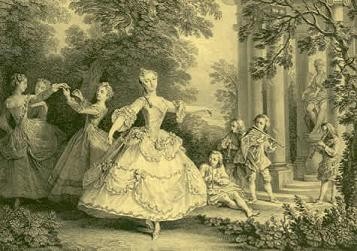Marie Sallé
From Londonhua WIKI
Revision as of 14:17, 5 June 2017 by Mthatfalvi (talk | contribs)
Marie Sallé
 Portrait of Maria Salle
Dancer and choreographer of the 18th century by I.Deshkova | |
| Year | 1730s |
|---|---|
Overview
The paragraph should give a three to five sentence abstract about your article. PLEASE NOTE: this article template has only a few sections as examples, but your actual article contributions should have many relevant sections and subsections. Please start to block out and complete those sections with relevant information such as the very objective, fact-based, and heavily referenced "who, what, when, where, and why" about this article. Articles don't just have to be huge buildings; individual artifacts and lesser-known people, places, and things count as article topics! Don't forget to include relevant category tags for each article!
Contents
Background
Begin writing the background information of this article, or use this format to begin a new article with some other relevant section filled with important information.
Bio
Marie Sallé was born 1707 in France and was a daughter of a tumbler. [1] She was taught dance a very early and made her debut in 1718 at the St. Laurent's Fair in an opera-comique by Lesaye titled La Princesse Carisme. [1]
//get another reference
She toured in fairs for years and in 1721 appeared for the first time in the Opera in Paris in Les Fetes Venitiennes. She became a student of Francoise Prevost at the Academie Royale, but the jealousy of the older danseuse kept her from advancing rapidly. In 1725 John Rich took her to London where she first appeared in Love's Last Shift in entreacte divertissement with her brother. She danced with her brother through- out her career. Later she danced in Caracteres de la Danse.
She stayed in London for two years and returned to Paris where she danced at the Opera. She danced a solo entree, but for the next few months was in the corps de ballet. In about a year however she was recognized as a dancer of great talent. The rivalry with Camargo which became a feature of both dancers' careers began at this time. During the next few years she alternated her time between London and Paris. She was a noted intellect and associated with the men of letters of her time.
She was a reformer in dance. In London in 1734 she appeared in her own production of "Pygmalion". She discarded the cumbersome dress of the day and danced in a muslin costume, her hair down and unornamented. This was in line with her belief that dance should be natural and expressive.
A review of her endeavor read: "For nearly two months Pygmalion has been given without any sign of failing interest...You can imagine, Sir, what the different stages of such an action can become when mimed and danced with the refined and delicate grace of Mlle. Sallé. She has dared to appear in this entree without pannier, skirt or bodice and with her hair down; she did not wear a single ornament on her head. Apart from her corset and petticoat she wore only a simple dress of muslin draped about her in the manner of a Greek statue."
Salle retired in 1740 and many of her reforms were adopted by her successors. She was championed by reformer Noverre who agreed with her precepts. As a dancer she was loved for her naturalness, grace and lack of affectation. As a women she was known for her intelligence and virtue.//
Performances
France
England
Pygmalion
Summary
This performance was shown on the 14th February 1734 with Marie Sallé as Galatea and choreographer. [2] The music was by Jean-Joseph Mouret. The ballet plot was about Pygmalion, king of Cyprus, who carved a statue of his ideal woman and fell in love with her. [3] Aphrodite then brought the sculpture to life and Pygmalion married her. The name Galatea was the name given to the statue for this interpretation and other performances [3] This performance was put on when the Royal Opera House was called Convert Gardens before the second fire. According to an article on Marie, she danced in a muslin costume with her hair down and un-ornamented which emphasized her belief that dance should be natural. [1]
Reviews
At the time, ballet dancers would dress in extravagant costumes with corsets. This did not give freedom for much movement. It was unheard of what Marie Sallé did in this performance. According to a review from her endeavor "For nearly two months Pygmalion has been given without any sign of failing interest...You can imagine, Sir, what the different stages of such an action can become when mimed and danced with the refined and delicate grace of Mlle. Sallé. She has dared to appear in this entree without pannier, skirt or bodice and with her hair down; she did not wear a single ornament on her head. Apart from her corset and petticoat she wore only a simple dress of muslin draped about her in the manner of a Greek statue." [1]
Marie was complemented in many reviews for her success & genius in her decision & performance. She even got to perform for the royalty of the day. One review from ..., about her performance said that, "Sallé had talents to open a thousand purses". Apparently she could bring a lot of people to a theater and the theater made money. Overall, this perfromance was a breakthrough in ballet history with costumes and style.
References
- ↑ 1.0 1.1 1.2 1.3 Andros, D. (1991, May). Marie Salle, (1707-1756). Retrieved June 05, 2017, from http://michaelminn.net/andros/biographies/salle_marie/
- ↑ Pygmalion (1734), accessed at http://www.apgrd.ox.ac.uk/productions/production/13155 <5 June 2017>
- ↑ 3.0 3.1 Reid, J. D., & Rohmann, C. (1993). The Oxford guide to classical mythology in the arts 1300-1900s (Vol. 2). New York: Oxford University Press.
External Links
If appropriate, add an external links section
Image Gallery
If appropriate, add an image gallery